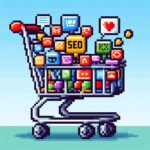An effective landing page can be the difference between capturing a potential customer’s interest and losing them to the vast expanse of the internet. Let’s dive into the key elements that make a landing page good.
Landing is not just a web page; it’s a carefully crafted tool designed to turn visitors into customers. Understanding the dynamics of what makes an effective landing page is crucial for anyone aiming to boost their online presence and drive meaningful actions.

Understanding the Purpose of Landing Page
Before diving into the specifics, it’s essential to clarify the purpose of your landing page. What do you want to achieve? Is it to sell a product, capture leads, or promote a service?
Identifying your goal is the first step toward creating a landing page that aligns with your business objectives.
Defining the Goal
Clearly defining your goal helps shape every element of your landing page, from the headline to the call-to-action button. Whether it’s to generate sales or encourage sign-ups, a focused goal guides your content strategy.
Target Audience
Knowing your audience is equally important. Tailor your landing page to address their needs, preferences, and pain points. A landing page designed for a specific audience is more likely to resonate and convert.
Elements of an Effective Landing Page
Now, let’s learn the anatomy of an effective landing page. Each element plays an important role in capturing and maintaining the visitor’s attention.
Compelling Headline
The headline is the first thing visitors see. It must be attention-grabbing, concise, and directly related to what the visitor expects to find.
Subheadings
Once you’ve hooked them with the headline, guide visitors through the page with persuasive subheadings. Break down information into digestible chunks to maintain interest.

Engaging Visuals
Humans are visual beings. Incorporate relevant images and videos that support your message. Visual content not only enhances understanding but also makes the page more memorable.
Clear Call-to-Action (CTA)
The CTA is the linchpin of your landing page. Craft a clear call-to-action that leaves no room for suspense. Use actionable language and make sure it stands out.
Trust Indicators
Building trust is very important in the online world. Include testimonials, reviews, security seals, and a clear privacy policy to instill confidence in your visitors.
Mobile Responsiveness
With the surge in mobile users, ensure your landing page is optimized for various devices. A seamless mobile experience is non-negotiable in today’s digital world.
Crafting a Compelling Headline For Landing Page
Importance of the First Impression
Your headline sets the tone for the entire page. It should offer a solution, or highlight a benefit. The first impression is paramount in holding the visitor’s attention.
Using Action Words
Incorporate action words that prompt the visitor to take the action. Whether it’s to buy, sign up, or learn more, the language should be dynamic and persuasive.
Addressing Pain Points
Understand the pain points of your audience and address them directly in the headline. Show that your product or service is the solution they’ve been searching for.
Writing Persuasive Subheadings
Breaking Down Information
Large blocks of text can be overwhelming. Use subheadings to break down information into manageable sections. Each subheading should entice the visitor to keep reading.
Ensure a logical flow from the headline to the subheadings. Guide the visitor through a narrative that gradually builds interest and anticipation.
Incorporating Engaging Visuals
Relevant Images and Videos
Visuals have the power to convey messages faster than text. Include images and videos that directly relate to your offering. Avoid stock photos that feel generic.
Visual content not only enhances the aesthetic appeal of your landing page but also reinforces your message. It’s a powerful tool to make your page more memorable.
Implementing a Clear Call-to-Action (CTA)
Your CTA should leave no room for confusion. Use direct and specific language. If you want them to buy, say “Buy Now.” If you want them to sign up, use “Sign Up Today.”
The placement of your CTA matters. It should be prominently displayed, ensuring visitors don’t have to search for it. Experiment with placement to find what works best.
Building Trust with Indicators
Testimonials and Reviews
Incorporate real testimonials and reviews from satisfied customers. Genuine feedback builds credibility and assures potential customers that others have had a positive experience.
If your landing page involves transactions or data input, display security seals prominently. It’s a visual cue that instills trust in the security of the transaction.
Be transparent about how you handle user data. A clear and accessible privacy policy is not just a legal requirement but also a trust-building measure.
Ensuring Mobile Responsiveness
The prevalence of mobile devices in our daily lives makes mobile responsiveness a priority. Ensure your landing page looks and functions seamlessly on smartphones and tablets. Invest in responsive design to adapt your landing page to different screen sizes. A positive mobile experience contributes significantly to user satisfaction.
A/B Testing for Optimization
Creating an effective landing page is an ongoing process. A/B testing allows you to experiment with different elements and fine-tune your page for optimal performance. Test different headlines, CTA buttons, colors, and images. Collect data on user interactions and use it to refine your landing page continually.
Analytics and Tracking
Utilize analytics tools to track user behavior on your landing page. Analyzing data provides insights into what works and what needs improvement. Google Analytics, Hotjar, and other tools offer valuable data. Use these insights to make informed decisions about your landing page strategy.
Conclusion
Crafting an effective landing page is both an art and a science. By understanding the essential elements and continuously refining based on user data, you can create a powerful tool that not only attracts but converts visitors into customers.
If you like this article, please share it with your friends





No responses yet